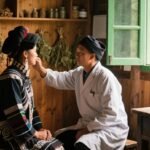Nijangdian (Oral Ulcers)
Overview
In Miao medicine, oral ulcers are referred to as Nijangdian, which describe blister-like lesions that form inside the mouth, eventually breaking open and developing into ulcers. This condition is believed to result from damp-heat pathogens entering the mouth, damaging the mucous membranes, and lingering to cause persistent inflammation along the meridians.
In Traditional Chinese Medicine (TCM), oral ulcers are considered a condition of mucosal imbalance, often caused by internal heat or a deficiency in qi and blood nourishment. It is characterized by small, painful ulcerations in the mouth with a burning sensation.
From a modern perspective, oral ulcers can appear anywhere in the mouth, commonly affecting the cheeks, lips, gums, and soft palate. They tend to be recurrent, with one or multiple round or oval-shaped lesions. The surface may be covered with a pale yellow or white pseudomembrane, sunken in the center, with red and swollen edges. The area is typically painful and sensitive. Conditions such as recurrent aphthous ulcers or minor oral inflammation fall under similar diagnostic considerations.
Classification in Miao Medicine
Nijangdian is considered a minor syndrome and is further categorized into:
Damp-toxin oral ulcers (associated with heat meridians and water imbalance)
Damp-heat oral ulcers (linked to stagnation of heat and dampness)
Pathogenesis (Aijiangduo · Causes)
In Miao medicine, Nijangdian is mainly caused by the intrusion of damp-heat toxins. Both internal imbalances (qi, blood, water) and external environmental factors are involved.
Dampness may arise from external humidity and often causes heaviness, fatigue, soreness, and joint discomfort.
Heat tends to rise, cause irritation and restlessness.
When dampness and heat combine and accumulate, they obstruct normal functions and may result in this condition.
Disease Mechanism (Gengduomeng · Underlying Pattern)
Water generates dampness, and when the body’s regulation is impaired, external heat and damp toxins invade. When these toxins enter through the mouth and remain stagnant, they injure the mucosal tissues and meridians, leading to ulceration.
Key Diagnostic Points
1. Diagnostic Criteria
Occurs anywhere in the oral mucosa; commonly seen on lips, cheeks, soft palate, or gums.
Lesions appear as one or more oval/round ulcers (3–5mm diameter), covered with a yellow-white pseudomembrane, sunken in the center, with red and slightly swollen surrounding tissues.
Typically painful.
Often triggered by spicy food, alcohol, or fatigue; characterized by periodic recurrence and self-resolving nature.

2. Supporting Examination
Oral mucosa appears shallowly ulcerated, usually round or oval.
One to several lesions may appear at a time.
Covered with light yellow discharge, surrounded by hyperemic mucosa.
Differential Diagnosis
1. Lailuolianjianggang (Similar to Cold Sores)
Nijangdian is usually accompanied by systemic symptoms like appetite loss or loose stools.
Pain is more intense than in lailuolianjianggang.
Cold sores are smaller, greyish-white in color, and often associated with bad breath and prolonged cycles.
Tends to recur when fatigued.
2. Kaigeninggong (Throat Lesion Similar to Scarlet Illness)
Typically has a history of wind-heat exposure and is contagious.
Nijangdian is not contagious and results from internal damp-heat toxin invasion.
Kaigeninggong is marked by sore throat, high fever, and red rash-like symptoms.
Nijangdian is localized to oral mucosa and features localized pain and redness.
Pattern Differentiation and Herbal Approaches
1. Heat Meridian with Water Toxin Type
Symptoms: Early symptoms include chills or fever, coughing, clear nasal discharge, vomiting, loss of appetite, followed by blistering and ulceration in the mouth.
Classification: Heat-related meridian condition
Treatment Principle:
Cool the blood, relieve discomfort
Clear heat and promote moisture balance
Herbal Formula:
Goosegrass (ebushicao) 15g
Cactus (xianrenzhang) 15g
Goldenrod (yizhihuanghua) 20g
Mahonia (shidagonglao) 20g
Boil in water and drink warm.
Herb Functions:
Goosegrass: Warming, penetrates cold meridians, clears stagnation
Cactus: Cooling, moves blood, dispels toxins
Goldenrod: Cooling and slightly toxic, dispels wind-heat
Mahonia: Cools heat, clears toxins
2. Damp-Heat Type
Symptoms: High fever, restlessness, painful mouth ulcers, dry mouth, dark-yellow urine, constipation.
Classification: Heat-related meridian condition
Treatment Principle:
Cool and activate blood
Clear heat and eliminate internal toxins
Herbal Formula:
Chicken gallbladder (a herb with same name)
Sankezhen (Triangular prickly herb)
Equal parts, boil in water and consume warm.
Herb Functions:
Chicken gallbladder: Cold and bitter, clears internal fire
Sankezhen: Cold and bitter, clears damp-heat and toxins
Preventive Care Recommendations
Avoid wind and cold; dress appropriately for the weather.
Maintain emotional balance; avoid excessive stress or worry.
Follow a gentle, nourishing diet; avoid spicy or irritating foods and alcohol.
Balance rest and activity; maintain regular routines.
Commentary
Humans live in constant interaction with the natural world. When environmental conditions exceed what the body can adapt to, imbalance may occur. As written in the Gazetteer of Qianzhou, “When spring shows light frost, and heat dominates all seasons, people tend to develop cold-type conditions. This is due to the damp earth, heavy fog, and sudden warm winters or cool rainy summers…”
Natural forces such as wind, dampness, cold, and heat are all considered external toxins. The human body constantly processes internal and external substances through circulation, transformation, and excretion. Under normal regulation, these remain in balance. But when the internal system becomes disordered and the environment changes abruptly, imbalance may lead to discomfort or illness.
Nijangdian results from the invasion of oral tissues by internal damp-heat toxins. The (used in traditional contexts) focuses on clearing heat, removing dampness, detoxifying, activating blood flow, and soothing discomfort.


Leave a Reply